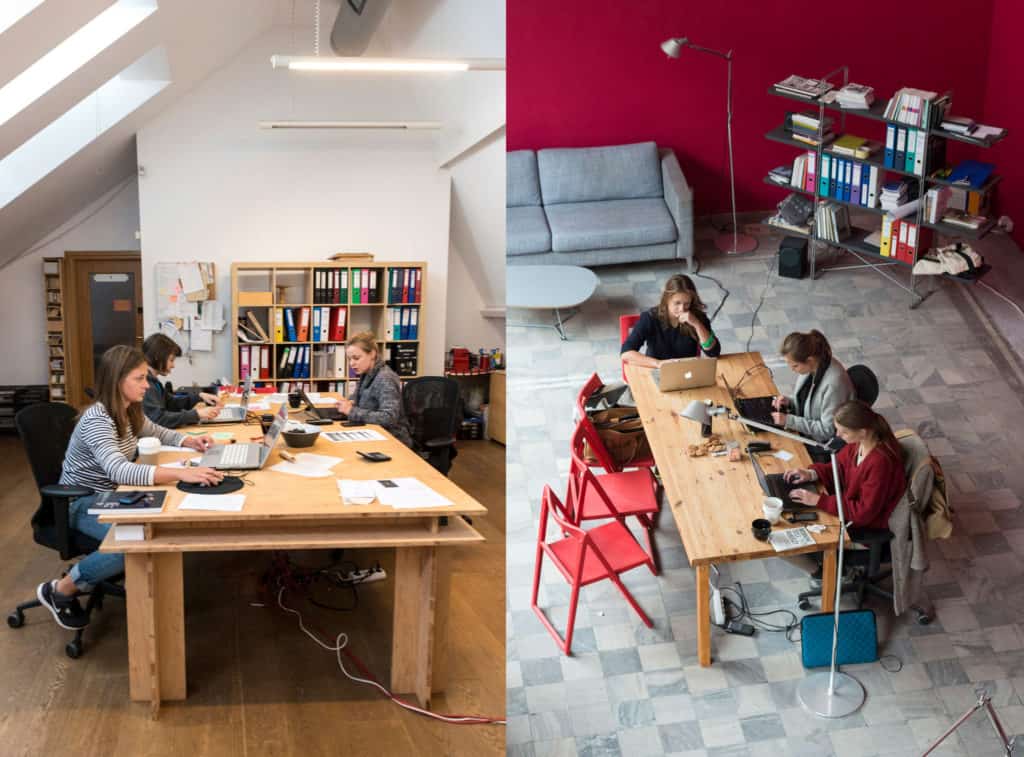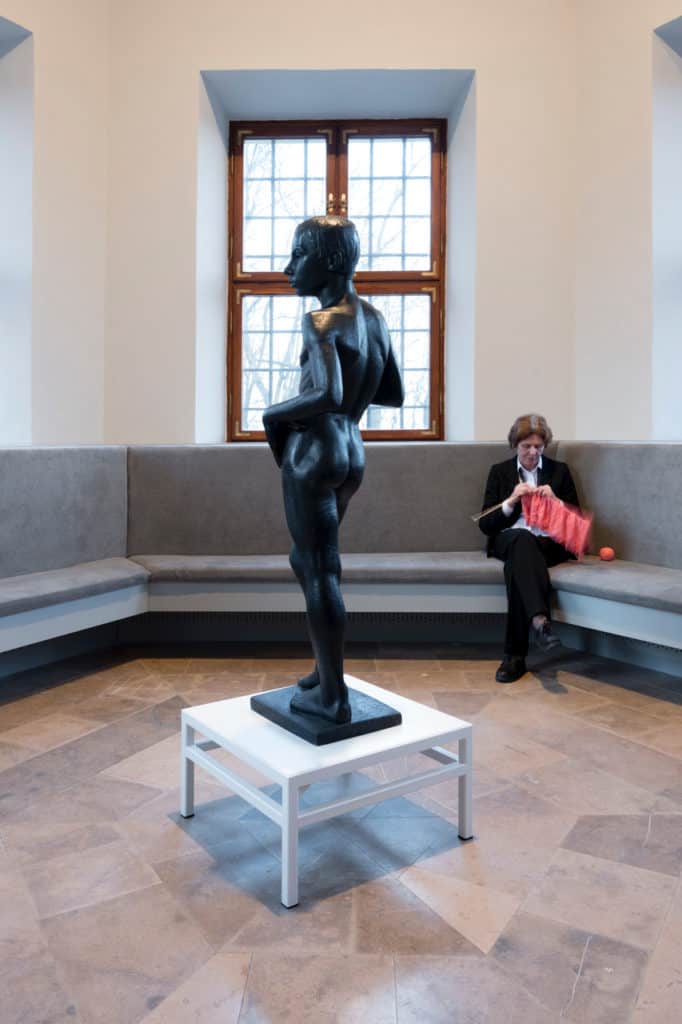
Maja Bekan, What Do We Do Whenever We Do Whatever This Is That We Do? (2014), site specific installation at shop venue in Warsaw. Photo: Bartosz Górka, courtesy of Ujazdowski Castle Centre for Contemporary Art
The residencies are becoming increasingly popular due to the mobility at a scale previously unknown. It is difficult to provide a clear definition of what an artistic residency is, as there are so many types, from small-scale residencies organised by individuals, to residencies organised by respectable institutions. In the series “Art Residency”, we talk to artists, curators and representatives of international organisations on their experience, challenges and tips.
Maria Markiewicz: Delfina Foundation, where you are currently one of the artists in residence, is the largest provider of international residencies in London. Residencies lately are a phenomenon, which interests many artists worldwide, but not all of them are aware of how residencies work and how to apply. Could you tell me how your residency at the Delfina Foundation started?
Maja Bekan: Well, I came here through the Mondriaan Fund, which is a Dutch public cultural funding organization supporting visual artists. After an initial interview with the Delfina director and curator, I was chosen as one of the artists in residence.
M.M.: Is this your first residency?
M.B.: No, I did a few residencies before I came here. Most of my residencies were organised through the Mondriaan Fund and these were in China, Poland and then in London. I would say that these three residencies were most important for my art practice. As I often work with site-specific installations and project constructions, I often work abroad and on various international residencies. I started working that way in 2011 and continue to do so, as being an artist in residence enables me to travel and to enter new spaces, to interact with people and to observe different social movements and phenomena in different parts of the world.

Maja Bekan, A series of Unexpected Incidents (2016), para-theatrical play: Photo: Bartosz Górka, courtesy of Ujazdowski Castle Centre for Contemporary Art and the artist
M.M.: Do you feel like residencies can significantly influence one’s practice or thinking?
M.B.: Each residency is different and depends on so many things. It depends on the people who you meet there and where you are with your work. But I would say that for some artists they make a difference, for example for me.
M.M.: Although each residency is different, many of them are mostly research-based and give artists some time to do a more in-depth investigation of the field they are interested in. Other residencies require artists to finalise a particular project…
M.B.: All of the residencies are different experiences. Some of them are more helpful for one’s practice, some less. Some are focused on production, so you have to have an idea you would like to develop, some are more research-based, like this one. Some of them can also be a beginning to a longer project, like my residency in Poland at the Ujazdowski Castle Centre for Contemporary Art, which was supported by the Mondriaan Fund and the City of Warsaw. It also lasted for three months but then it kind of extended into three years of different constructed artistic activities between the people and the art institution, initiated by me.

Maja Bekan, Essential Environment No.4 Social Room (2017) installation view of the exhibition: Maja Bekan, 23 Assemblies (2017). Photo: Bartosz Górka, courtesy of Ujazdowski Castle Centre for Contemporary Art
M.M.: Your residency in Warsaw ended with the exhibition 23 Assemblies. Could you tell me a bit more about it?
M.B.:I think I went to Ujazdowski Castle for the first time in 2014, just before the elections. That was the first time I went to Warsaw. My residency was part of the program Re-Directing: East, a few curators were part of it and each of them recommended an artist that they thought would be interesting to bring. I was invited by High&Low Bureau, a curatorial duo composed of Yael Messer and Gilad Reich. During my residency in Warsaw, I started to closely collaborate with curators, one of them being Ania Ptak, and somehow it all started organically. After a year, I came to Warsaw again, as we already started working on A Series of Unexpected Events. It was a project involving both educational and performative actions, such as lectures, visits to museums and paratheatrical events, and I stayed in Warsaw for the next three years, during which I was closely working with a group of elderly activists. The project began as a series of performances, theatre plays and films, and evolved into an exhibition.

Maja Bekan, Essential Environment No.1 Performance Class (2017) view of the performance class at action: Maja Bekan, 23 Assemblies (2017). Photo: Bartosz Górka, courtesy of Ujazdowski Castle Centre for Contemporary Art
M.M.: In 23 Assemblies, you worked closely with the gallery guards, who in Poland are very often older, retired people, mostly women. I found it very interesting because when I was a child there was always something in these people what fascinated and frightened me at the same time…
M.B.: For me, they were the first thing you would encounter when entering the gallery space to see what is in there. Their presence was so strong. You see these people, often older than you, usually female, getting up from their seat as soon as you enter the gallery… I felt very guilty. At one side you somehow care for them, but on the other you also feel controlled, because they follow you around. You wonder all the time what you are doing wrong. I felt like it was such a strong, strange relationship of control they created. Spending time in the institution and getting to know these people better turned into a new artwork when the exhibition came about. They became such amazing and inspiring collaborators and their performance work in the Social Room was very moving.

Maja Bekan, installation view of the exhibition: Maja Bekan, 23 Assemblies (2017). Photo: Bartosz Górka, courtesy of Ujazdowski Castle Centre for Contemporary Art
M.M.: In your works, you often talk about people who are being excluded by society. They are retired people, older women or sometimes teenagers. Although society seems to marginalise them, they are indeed people who have the real power, and your works are pointing out to this paradox.
M.B.: I enjoy working with people who you meet on a daily basis. Guards, volunteers, people who are present in certain spaces all the time but who often go unnoticed. The guards at the Ujazdowski Castle were for me the face of this institution. I wanted to work with them and to simply give them some time and space to enjoy. We designed a space where they were sitting, and we told them: you can do whatever you want, all the things you are not allowed to, and that’s exactly what they did.

Maja Bekan, Essential Environment No.4 Social Room (2017) installation view of the exhibition: Maja Bekan, 23 Assemblies (2017). Photo: Bartosz Górka, courtesy of Ujazdowski Castle Centre for Contemporary Art
M.M.: In your practice you often invite other people, both artists and amateurs, to work together through the body of performance. Could you tell me how it all started?
M.B.: I started collaborating with different artists in 2008 when I initiated my project P for Performance. The project was hosted by me and 5 different artists, together with whom we established an artist-run space, where we were staging various events for like-minded people, interested in art and research. I thought, alright, I don’t want to work only on my practice, I want to connect with other people, so I started with inviting different artists to do some pieces together. We were not publicly funded, and we only had our studios, parks, streets and the internet. When I worked with artists who were based abroad we were doing Skype performances. It was really rewarding and influenced how I work and how I think. At the same time, I was making a piece about my mum, because I’ve moved away from Serbia, my motherland, and that’s how we kind of started to work together permanently. We both come from very different worlds. I wanted her to understand me and I also wanted to understand her, so we started working together and that’s how these people from outside of art came through, starting with her.

Maja Bekan, installation view of the exhibition: Maja Bekan, 23 Assemblies (2017). Photo: Bartosz Górka, courtesy of Ujazdowski Castle Centre for Contemporary Art
M.M.: What are you working on at the moment?
M.B.: Delfina now has a program devoted to gender, the public space and politics and that fits perfectly with my work and research. I came here without a plan. I always use performance as a tool to generate my works. Mostly, I’m working here on my research, I’m meeting a lot of people and just trying to expand my knowledge. There is a lot of things happening and I’m also working on a big exhibition in Serbia but for now, that’s all I can unveil.

Maja Bekan, installation view of the exhibition: Maja Bekan, 23 Assemblies (2017). Photo: Bartosz Górka, courtesy of Ujazdowski Castle Centre for Contemporary Art.








